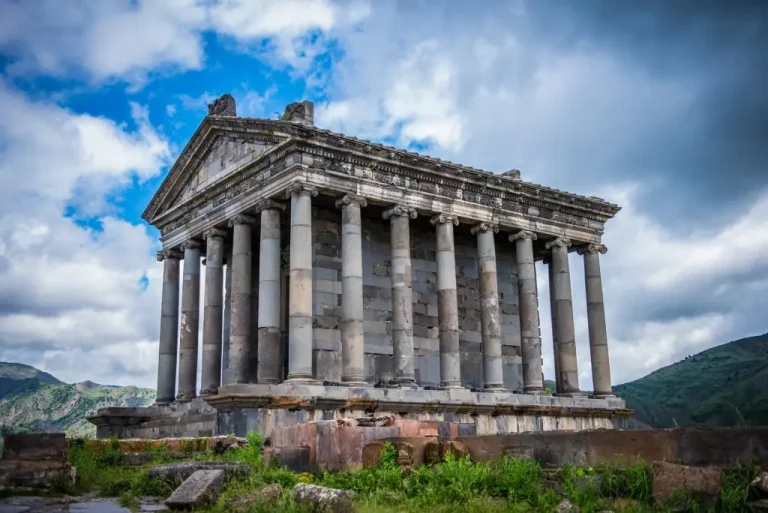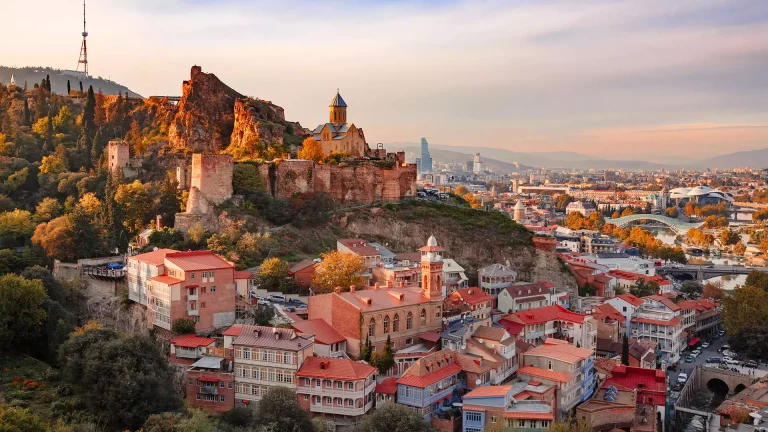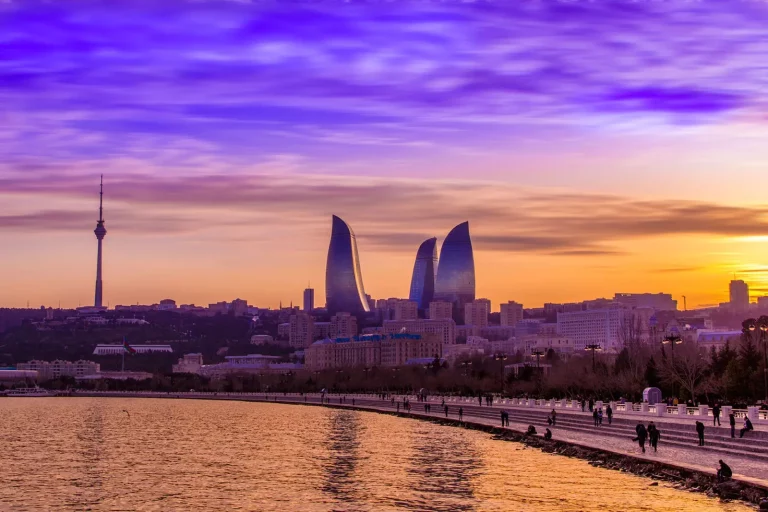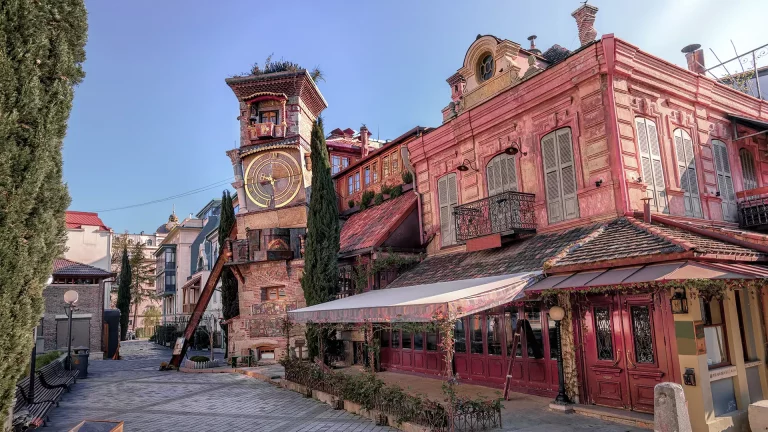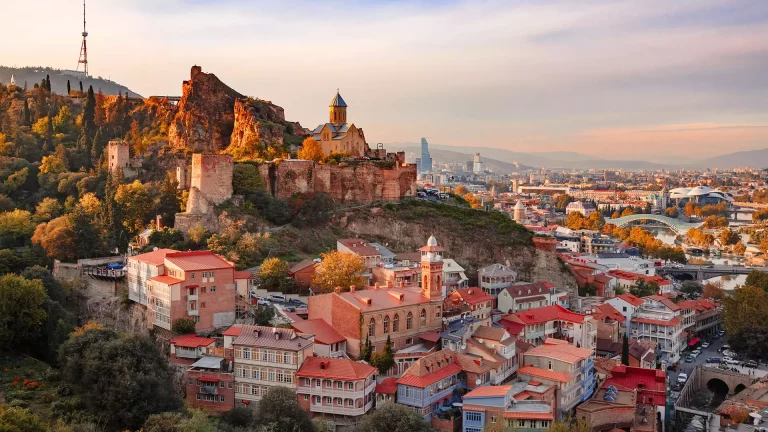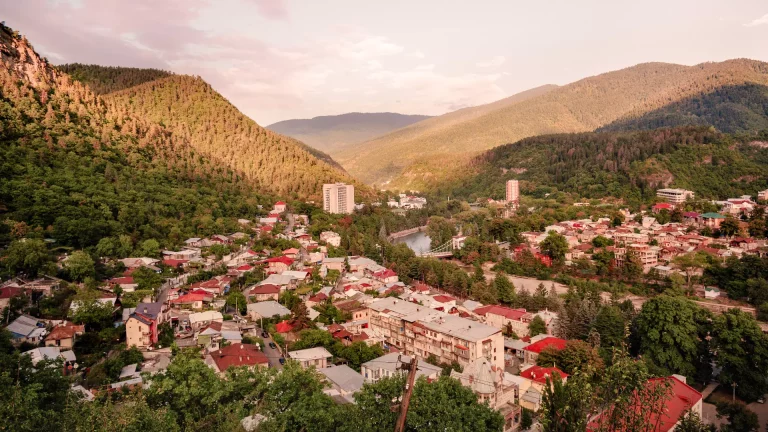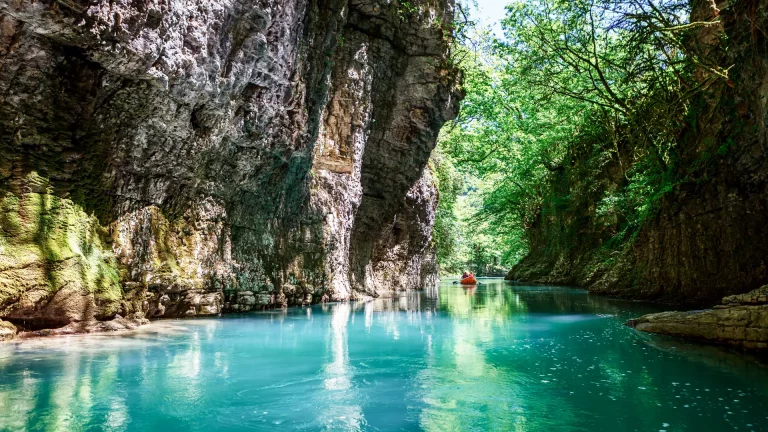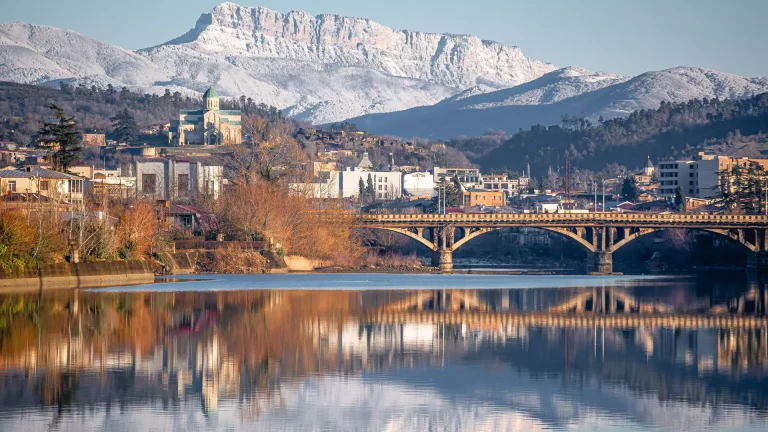Itinerary
Best Of Azerbaijan Georgia Armenia Tour Package
11 Days
- Private Tour
- Starting from Baku
- 11 Days – 10 Nights
SHORT OVERVIEW:
| DAY 1 | Baku |
| DAY 2 | Baku – Ateshgah – Heydar Aliyev Centre – Gobustan – Baku |
| DAY 3 | Baku – Gabala – Shamakhi – Lahich – Sheki |
| DAY 4 | Sheki – Georgian border – Kvareli – Telavi |
| DAY 5 | Kakheti |
| DAY 6 | Tbilisi- Jvari-Mtskheta-Tbilisi |
| DAY 7 | Kazbegi |
| DAY 8 | Tbilisi-Georgia-Armenia border-Hagarcin-Sevan-Sevanavank-Yerevan
|
| DAY 9 | Yerevan – Garni Temple – Geghard Monastery |
| DAY 10 | Yerevan- Tbilisi |
| DAY 11 | Departure |
PRICES & INCLUDED LIST: SEE LAST PAGE
DETAILED TOUR PROGRAM
Day 1: Baku – Arrival – City Tour
Arrive in Baku and transfer to the hotel (check in is possible from 12:00). After a short break, start a guided sightseeing tour of Baku. Walk along Martyrs’ Lane, known as ‘Shehidler Khiyabany’ among locals, and find a beautiful view overlooking Baku’s coastline. Move to Icheri Sheher, the old part of the city. Visit the Shirvanshah’s Palace, Caravanserai, Maiden Tower, and main market square, which has numerous art studios and souvenir stalls. Finish the sightseeing tour by exploring Nizami Street and Fountain Square. Overnight at the hotel.
Duration of sightseeing tour: 4-5 hours
Day 2: Baku – Ateshgah – Heydar Aliyev Centre – Gobustan – Baku
After breakfast, drive to Ateshgah, located in the village of Surakhany. Zoroastrians from India used to travel thousands of kilometres to Ateshgah to worship the fire coming out of the earth. Return to Baku to visit the iconic Heydar Aliyev Cultural Centre, which is in a quirky building designed by Iraqi-British architect Zaha Hadid. The Centre showcases examples of a wide spectrum of Azerbaijani culture, with national costumes, musical instruments, and carpets providing a good insight into local craftsmanship. In the afternoon, drive to Gobustan to visit the Petroglyphs Museum and explore petroglyphs dating back to 10,000 BC. The Gobustan Rock Art Cultural Landscape is a UNESCO World Heritage Site. Weather permitting, switch to a 4×4 vehicle and continue to the mud volcanoes (Gobustan is home to almost half of the world’s mud volcanoes). Return to Baku for overnight at the hotel.
Duration of sightseeing tour: 8-9 hours
Day 3: Baku – Gabala – Shamakhi – Lahich – Sheki
Breakfast. Depart Baku and drive towards Sheki. Visit Gabala resort. On the way, stop at the Diri Baba Mausoleum in Maraza village. Continue to Shamakhi to visit the historical Juma Mosque, which was restored in 2013. Weather permitting, this will be followed by a scenic drive through the Girdimanchay River Canyon to the 5th century village of Lahich. Lahich is rich in historic and cultural value, with charming cobbled streets. It is famous for its medieval water supply and sewage systems and its many traditional workshops where jewelry, copperware, carpets, pottery, daggers, and iron tools are made. Continue driving to Sheki, a pleasant and easily walkable medieval town set in a lush mountainous area, which is particularly famous for its sweet baklava. Arrive in Sheki at about 19:00 and spend the night at a hotel.
Duration of sightseeing tour: 10-11 hours
Day 4: Sheki – Georgian border – Kvareli – Telavi
At 08:30, after breakfast and hotel check-out, visit the colourful Sheki Bazaar. Here, you can find virtually everything you may want to eat, including local fruits and berries, spices, freshly-baked bread, honey, cheeses, and Sheki sweets. Continue to the Sheki Khans Palace, which is surrounded by medieval fortress walls, and then explore the handicrafts workshops and the famous caravanserai. Depart Sheki and head towards the border with Georgia (115 km, ~2 h). Cross the border and start exploring the eastern part of Georgia, which is famous for its viticulture and winemaking traditions. The first stop will be the Khareba Winery, near the town of Kvareli. On the way there, enjoy the picturesque landscapes of vineyards and wine-producing villages. Khareba’s unique wine cellar is in a tunnel carved out of the rock. Originally built for military purposes, today the tunnel is used to store Kakheti’s finest wines. Enjoy a winery tour and a tasting session. Continue to Telavi and check in to your hotel. Overnight at the hotel.
Duration of sightseeing tour: 7-8 hours
Day 5: Telavi – Tsinandali – Sighnaghi – Bodbe – Tbilisi
After breakfast, take a short walk through the charming streets of Old Telavi, stopping for photos at the monument to Erekli II and the giant plane tree that is more than 900 years old. Then continue exploring the Kakheti Region by visiting Tsinandali Palace, the former residence of Georgian dukes. Prince Chavchavadze, a 19th century public figure and poet, turned the Estate into what it is today, with a beautiful English-style garden, a museum, and a wine cellar. The next stop is Sighnaghi, the Royal Town and “City of Love”. This city, surrounded by defensive walls with 23 towers, was an important trading center on the Great Silk Road. Continue to Bodbe Convent – according to legend, this is the burial place of St. Nino, who converted Georgia to Christianity in the 4th century. Since 1889, following a decree by Tsar Alexander III of Russia, Bodbe Convent functions as a nunnery. Arrive in the capital of Georgia, Tbilisi. Overnight at a hotel.
Duration of sightseeing tour: 6-7 hours
Day 6: Tbilisi- Jvari-Mtskheta-Tbilisi
Breakfast, followed by a sightseeing tour of Tbilisi. Start at Metekhi Church and the monument to Vakhtang Gorgasali, the legendary founder of Tbilisi. Visit Narikala Fortress to enjoy a breathtaking panoramic view of the city. Walk past Tbilisi’s only mosque, down to the sulphur bath house district. Enjoy a stroll through the Sharden area, which is full of narrow streets with cozy cafés, wine bars, and souvenir shops, and breathe in the history of Old Tbilisi. Also visit Sioni Cathedral, Anchiskhati Basilica, and the famous Rezo Gabriadze Theatre’s clock tower, before crossing the Bridge of Peace to Rike Park. Then we will visit Jvari monastery (UNESCO WORLD HERITAGE SITE)
After Jvari, visit Mtskheta, one of the oldest towns in Georgia and the country’s cultural and religious centre. Mtskheta was the capital of the eastern Georgian Kingdom of Kartli from the 3rd century BC. Visit Svetitskhoveli, which is the main cathedral of Mtskheta and a sacred place where the robe of Christ is kept. Overnight at a hotel.
Day 7: Tbilisi-Ananuri-Jinvali-Gudauri-Kazbegi-Tbilisi
Breakfast. After the hotel breakfast, drive to the direction of Gudauri. On the way visiting Ananuri Fortress which is located directly on the Georgian Military Road. Ananuri was also a former residence of Argveti Dukes, which features churches and towers dating back to the 16th and 17th centuries. Jinvali Reservoir is one of the most beautiful places in Georgia. The lake is surrounded on all sides by green mountains covered with deciduous and pine forests. The most convenient way to admire the views of Jinvali reservoir is from Ananuri Castle. Continue driving towards Gudauri. Stop near The Arch of Friendship for photo shooting. The monument was built together with an observation deck back in 1983 in the name of friendship between the Russian and Georgian peoples. Continue the way to Kazbegi. 4×4 vehicle trip to Gergeti Trinity church (located at an altitude of 2,170m) and enjoy breathtaking views of Mount Kazbegi. Drive back to Tbilisi. Overnight at a hotel.
Day 8: Tbilisi-Georgia-Armenia border-Hagarcin-Sevan-Sevanavank-Yerevan
After breakfast drive to the direction of Georgia-Armenia border. On the way to Yerevan visiting Hagarcin Monastery – which is located 18 kilometers from Dilijan, far from populated areas, among dense forests and magnificent mountain landscapes. The name of the monastery from Armenian is translated as “games of eagles”. The image of this proud bird can often be seen on the walls of Hagarcin. Our next stop is lake Sevan sightseeing – Set 1900m above sea level it’s the largest lake in the Caucasus and one of the largest freshwater high-altitude lakes in the world. Its colors and shades change with the weather, forming dazzling azure to dark blue hues, and a thousand shades in between. Savanavak – In the northwest part of Sevan Lake, on a narrow rocky peninsula, there stands one of the most prominent examples of medieval Armenian architecture – Sevanavank Monastery. Today the two black temples of Sevan stand deserted like two guards of this ancient lake. The view from there is simply magnificent: the mountains surround lake from all sides and snow tops are seen almost on the entire perimeter and disappear behind horizon. And behind the horizon of the dark blue open water space shrouded in fog are the green mountain slopes whose tops are covered with snow even in summer. Arrival in Yerevan and overnight.
Day 9: Yerevan – Garni Temple – Geghard Monastery
Breakfast. Visiting Garni temple, which towers over a triangular cape, is the unique survived example of heathen culture in Armenia. It is a blend of Greco-Roman and Armenian styles. According to the research of some historians, the temple was created by the Armenian king Trdat I, who ruled in the second half of the 1st century and dedicated it to the Armenian God of Sun – Mihr. After adopting Christianity in 301, the pagan temple lost its significance and the fortress of Garni became the summer residence of the kings. Nowadays the ruins of the royal palace and the bathroom with a stunning mosaic work can be found near the temple. The temple is loved by both local and guests, because the temple is not like other religious monuments in Armenia, and when you are closer, it seems that you are in little Greece with an Armenian spirit.
Our next stop is the monastery of Geghard or Gegardavank which is located in a gorge between high suspended rocks, between mountains covered with thick forests. The monastery itself and its cells are carved into the rock and contains a number of churches and tombs, most of them cut into the rock, which illustrate the very peak of Armenian medieval architecture. Drive back to Yerevan.
Day 10: Yerevan-Khor Virap Monastery – Noravank Monastery – Areni Winery-Tbilisi
Breakfast. Visiting Khor Virap (Khor means deep, Virap – pit, dungeon) – one of the Armenian shrines, which in ancient times was a famous place of pilgrimage. However, Khor Virap is important for Armenians not only for its connection with Christianity: the monastery is closely associated with the symbol of Armenia. It is from here that the unimaginable view of Mount Ararat opens. Due to circumstances, the symbol of Armenia Ararat today is not in its historic homeland, but in Turkey, and the monastery of Khor Virap is 40 km away from the mountain and from the Turkish border. If you look closely, you can see the border posts of Turkey. The beautiful Noravank Monastery (“Nor” – new, “vank” – monastery) was built in the 13th century and stands majestically in the gorge of the river Arpa, and in the gorge, makes the view even more impressive. The spare lines of the church contrast beautifully with the sharp red rock cliffs, and the dramatic scenery is one of the best reasons to visit Noravank. And our last activity is wine degustation in Areni winery.
Drive back to Tbilisi city and overnight in Tbilisi
Day 11: Departure
Check-out from the hotel. Transfer to Tbilisi International Airport. End of the tour.
| Price includes: | 1. All transfers (1-2 pax by sedan, 3-6 pax by minivan, 7-18 pax by Sprinter passenger van); 2. Accommodation based on double/twin room sharing, breakfasts included (Tbilisi Reikartz King Tamar or similar; Yerevan Konyak or similar . Baku hotel Sunday or similiar . Old Telavi hotel ); 3. Sightseeing tour program; 4. Entrance tickets to sights as per itinerary; 5. Separate 4×4 vehicle to Gergeti Triniry; 6. Bottled drinking water |
| Price does not include: | 1. Full board; 2. Hotel charges for additional services; 3. Personal travel insurance; 4. Tips are not included but would be appreciated. |

